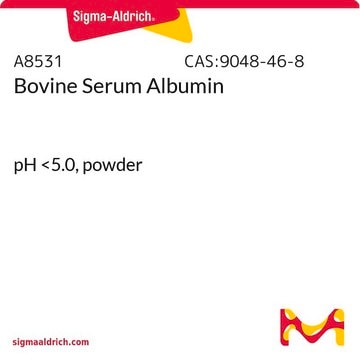1.15444
Coomassie Brilliant blue G 250 (C.I. 42655)
for electrophoresis
Synonyme(s) :
Coomassie Brilliant blue G 250 (C.I. 42655), Acid blue 90, Brilliant Blue G, Cyanine G, Polar Blue G, SERVA BLUE G, protein gel stain
About This Item
Produits recommandés
Niveau de qualité
Puissance
>5000 mg/kg LD50, oral (Rat)
Technique(s)
protein staining: suitable
pH
6.4 (20 °C, 10 g/L in H2O)
Solubilité
40 g/L
Masse volumique apparente
520 kg/m3
Température de stockage
no temp limit
InChI
1S/C47H49N3O7S2.Na/c1-6-49(31-35-11-9-13-43(29-35)58(51,52)53)40-21-25-45(33(4)27-40)47(37-15-17-38(18-16-37)48-39-19-23-42(24-20-39)57-8-3)46-26-22-41(28-34(46)5)50(7-2)32-36-12-10-14-44(30-36)59(54,55)56;/h9-30,48H,6-8,31-32H2,1-5H3,(H-,51,52,53,54,55,56);/q;+1/p-1
Clé InChI
CMGWKYXJIYYESN-UHFFFAOYSA-M
Catégories apparentées
Description générale
Application
Remarque sur l'analyse
Absorption maximum λmax. (buffer pH 7.0): 577 - 584 nm
Spec. Absorptivity A 1%/1cm (λmax; 0.01 g/l; buffer pH 7.0; calc. on dried substance): 450 - 570
TLC-Test: passes test
Loss on drying (110 °C): ≤ 8 %
Suitability for electrophoresis: passes test
Informations légales
Code de la classe de stockage
11 - Combustible Solids
Classe de danger pour l'eau (WGK)
WGK 3
Point d'éclair (°F)
Not applicable
Point d'éclair (°C)
Not applicable
Certificats d'analyse (COA)
Recherchez un Certificats d'analyse (COA) en saisissant le numéro de lot du produit. Les numéros de lot figurent sur l'étiquette du produit après les mots "Lot" ou "Batch".
Déjà en possession de ce produit ?
Retrouvez la documentation relative aux produits que vous avez récemment achetés dans la Bibliothèque de documents.
Les clients ont également consulté
Articles
Identify causes and remedies for SDS-PAGE sample preparation challenges and optimize electrophoresis conditions.
Notre équipe de scientifiques dispose d'une expérience dans tous les secteurs de la recherche, notamment en sciences de la vie, science des matériaux, synthèse chimique, chromatographie, analyse et dans de nombreux autres domaines..
Contacter notre Service technique








